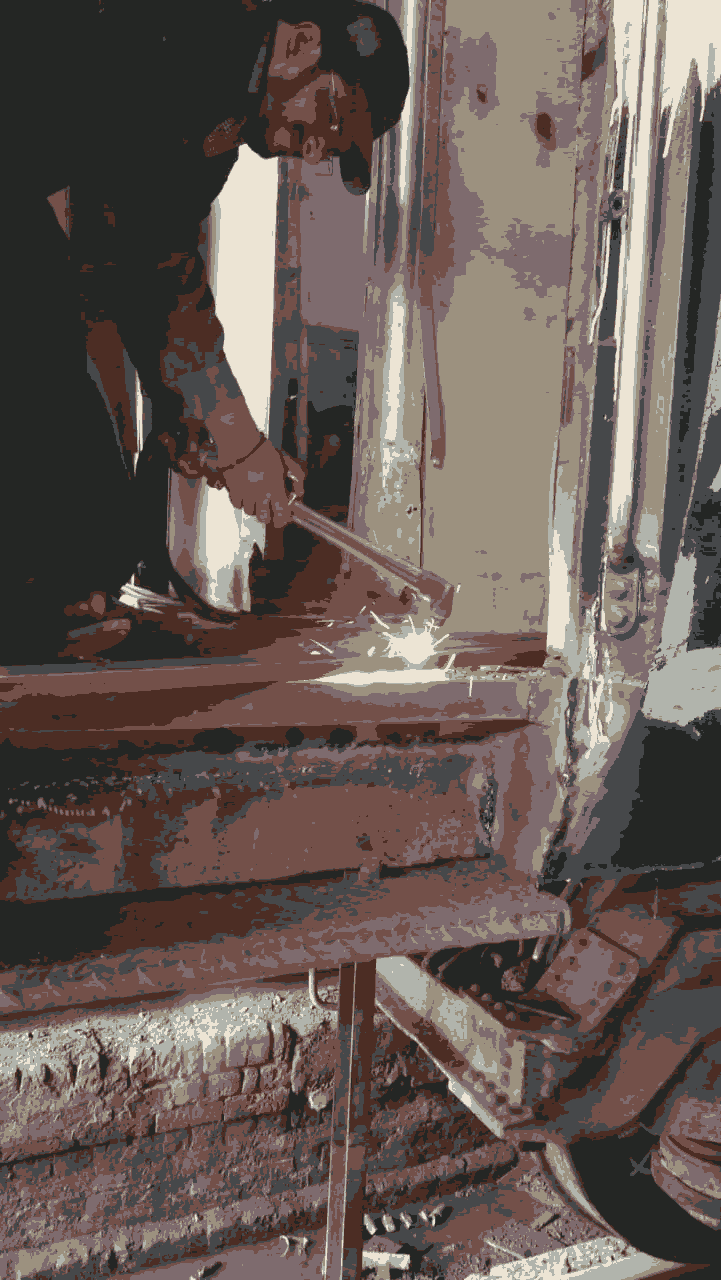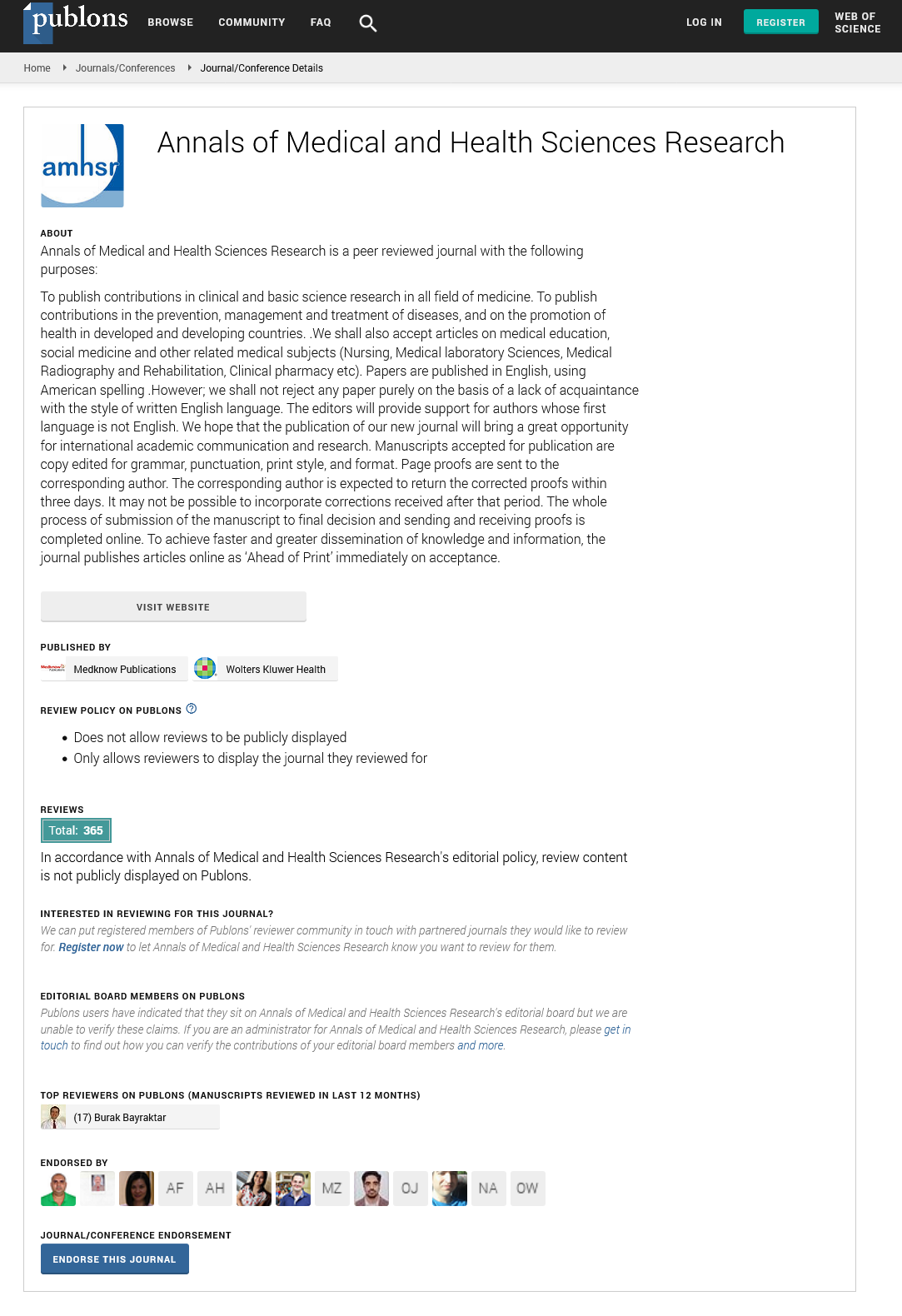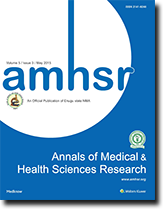Prevalence of Musculoskeletal Disorders among Manual Workers in Railway Workshops Lahore
2 Department of Physiotherapy, Riphah International university, Lahore, Pakistan, Email: naveed.anwar@uipt.uol.edu.pk
, DOI: 10.54608.annalsmedical.2021.13
Citation: Irshad A, et al. Prevalence of Musculoskeletal Disorders among Manual Workers in Railway Workshops Lahore. Ann Med Health Sci Res. 2021;11:1512-1516.
This open-access article is distributed under the terms of the Creative Commons Attribution Non-Commercial License (CC BY-NC) (http://creativecommons.org/licenses/by-nc/4.0/), which permits reuse, distribution and reproduction of the article, provided that the original work is properly cited and the reuse is restricted to noncommercial purposes. For commercial reuse, contact reprints@pulsus.com
Abstract
Our study aims to find the prevalence of the musculoskeletal disorder among manual workers of the railway. Manual workers in our study were welders, helpers, painters, blacksmiths, coachbuilders and manual machine handlers working for a year in railway. It is an observational study with a sample sizeof 300 male manual workers of Pakistan railway, Lahore. Prevalence of musculoskeletal disorderin the last 12 months was determined using the Nordic musculoskeletal questionnaire. 96% of manual workers reported musculoskeletal disorders in at least 1 body region in the previous 12 months. The most prevalent areas were lower back (71.3%), shoulders (50.7%), knees (48%) and upper back (41.3%). Other areas had following prevalence rate elbows (16%), hips (11.7%), ankles (11%), neck (7.7%) and wrist and hands (3.3%). This study concludes high prevalence of musculoskeletal disorders among manual workers of the Lahore railway that can cause further morbidities and functional limitations.
Keywords
Prevalence; Musculoskeletal disorders; Orthopedicdisorders; Manual worker; Railway workers
Introduction
Musculoskeletal disorders have a greater prevalence and severe consequences for the workers. [1] According to the previous researches in Asia prevalence of musculoskeletal symptoms was 65% in Railway Sahayaks (coolie) of India. [2] Similarly 95% of manual workers in Calcutta, India reported musculoskeletal disorders. [3]
These Musculoskeletal disorders cost approximately 171.7 million USD dollars in developing countries. [2] Al-Dubai et al. conducted a cross-sectional study on 513 railway workers in 8 different states of Malaysia. To determine the relationship of high-risk working behaviors to the highly prevalent knee pain, they collected data on socioeconomic status, occupational safety, risky job tasks, and knee pain complaints. Results revealed a 31.6% prevalence of knee pain in the last 1 year. Also, a significant relationship was found between knee problems and work-related factors. [3] Hossein et al. conducted a cross-sectional study in 2011 to evaluate the prevalence of work-related musculoskeletal disorders and related factors among 160 welders working at a petrochemical complex in south Iran. The Nordic musculoskeletal questionnaire was used. WMSDs occurred at a high rate (88.3%) among these workers, suggesting ergonomic intervention's need. Most affected regions were shoulder, wrist and hand. [4]
In the United States, Canada, Finland, Sweden, and England, musculoskeletal disorders become a reason for most work absentees. [5] Despite the mechanization in the industries all over the world, workers in these industries still have to carry out manual material handling tasks for earning. Repetitive arm movements are associated with neck pain and upper extremity symptoms. [6] The worldwide lifetime prevalence of work-related low back pain ranges between 30%-84%. [7] In Pakistan, the problems associated with the health of laborers given very little importance. Very few sectors work on occupational health problems all over the country [Tables 1-3].
| Demographic Descriptive Statistics | Frequency | Percentage | Mean | Std. deviation | |
|---|---|---|---|---|---|
| Age(years) | 20-30 | 11 | 3.7 | 48.61 | 9.004 |
| 31-40 | 62 | 20.7 | |||
| 41-50 | 75 | 25 | |||
| Greater Than 50 | 152 | 50.7 | |||
| Total | 300 | 100 | |||
| BMI(kg/m²) | 15-25 | 92 | 30.7 | ||
| 26-35 | 141 | 47 | |||
| 36-45 | 64 | 21.3 | |||
| Greater than 45 | 3 | 1 | |||
| Total | 300 | 100 | |||
| Education | illiterate | 67 | 22.3 | ||
| Primary | 173 | 57.7 | |||
| Secondary | 35 | 11.7 | |||
| Bachelors | 25 | 8.3 | |||
| Total | 300 | 100 | |||
| Smoking | No | 173 | 57.7 | ||
| Yes | 127 | 42.3 | |||
| Total | 300 | 100 | |||
| Experience | 2-10 Years | 27 | 9 | 25.2 | 10.18 |
| 11-20 Years | 86 | 28.7 | |||
| 21-30 years | 85 | 28.3 | |||
| Greater than 30 years | 102 | 34 | |||
| Total | 300 | 100 | |||
| Posture | Sitting | 33 | 11 | ||
| Standing | 230 | 76.7 | |||
| Both | 37 | 12.3 | |||
| Total | 300 | 100 | |||
| Training | No | 89 | 29.7 | ||
| Yes | 211 | 70.3 | |||
| Total | 300 | 100 | |||
| TrainingDuration (Years) | 0 | 89 | 29.7 | ||
| 1 | 70 | 23.3 | |||
| 2 | 3 | 1 | |||
| 3 | 135 | 45 | |||
| 4 | 3 | 1 | |||
| Total | 300 | 100 | |||
| Exertion | Mild | 108 | 36 | ||
| Moderate | 87 | 29 | |||
| High | 105 | 35 | |||
| Total | 300 | 100 | |||
Table 1: Descriptive statistics of demographic variables.
| N | Percentage | ||
|---|---|---|---|
| Disorder | No | 3 | 1 |
| Yes | 297 | 99 | |
| Total | 300 | 100 | |
| MSK | No | 14 | 4.7 |
| Yes | 286 | 95.3 | |
| Total | 300 | 100 | |
| Pulmonary | No | 202 | 67.3 |
| Yes | 98 | 32.7 | |
| Total | 300 | 100 | |
| ENT | No | 262 | 87.3 |
| Yes | 38 | 12.7 | |
| Total | 300 | 100 | |
| Psychological | No | 202 | 67.3 |
| Yes | 98 | 32.7 | |
| Total | 300 | 100 | |
| CVS | No | 186 | 62 |
| Yes | 114 | 38 | |
| Total | 300 | 100 | |
| Metabolic | No | 234 | 78 |
| Yes | 66 | 22 | |
| Total | 300 | 100 |
Table 2: Presence of systemic disorders among participants.
| Trouble in last 12 months | Trouble in last 7 days | ||
|---|---|---|---|
| Body Regions | Frequency ( Percent) | Frequency ( Percent) | |
| Neck | No | 277 (92.3%) | 295 (98.3%) |
| Yes | 23 (7.7%) | 5 (1.7%) | |
| Total | 300(100.0%) | 300(100.0%) | |
| Shoulders | No | 146 (48.7%) | 296 (98.7%) |
| Right shoulder | 30 (10.0%) | 2 (0.7%) | |
| Left shoulder | 5 (1.7%) | 2 (0.7%) | |
| Both shoulder | 119 (39.7%) | ||
| Total | 300(100.0%) | 300(100.0%) | |
| Elbows | No | 248 (82.7%) | 293 (97.7) |
| Right elbow | 23 (7.7%) | 5 (1.7) | |
| Left elbow | 3 (1.0%) | 1 (0.3%) | |
| Both elbow | 26 (8.7%) | 1 (0.3%) | |
| Total | 300(100.0%) | 300(100.0%) | |
| Wrists/hands | No | 290 (96.7%) | 298 (99.3%) |
| Right wrist/hand | 4 (1.3%) | 2 (0.7%) | |
| Both wrists/hands | 6 (2.0%) | ||
| Total | 300(100.0%) | 300(100.0%) | |
| Upper back | No | 176 (58.7%) | 295 (98.3%) |
| Yes | 124 (41.3%) | 5 (1.7%) | |
| Total | 300(100.0%) | 300(100.0%) | |
| Lowerback | No | 86 (28.7%) | 297 (99.0%) |
| Yes | 214 (71.3%) | 3 (1.0%) | |
| Total | 300(100.0%) | 300(100.0%) | |
| Hips/thighs/buttocks | No | 265 (88.3%) | 300 (100.0%) |
| Yes | 35 (11.7%) | ||
| Total | 300(100.0%) | 300(100.0%) | |
| Knees | No | 154 (51.3%) | 296 (98.7%) |
| Yes | 146 (48.7%) | 4 (1.3%) | |
| Total | 300(100.0%) | 300(100.0%) | |
| Ankles/feet | No | 267 (89.0%) | 297 (99.0%) |
| Yes | 33 (11.0%) | 3 (1.0%) | |
| Total | 300(100.0%) | 300(100.0%) | |
Table 3: Nordic Musculoskeletal Questionnaire Statistics.
In the current research work, we planned to find the prevalence of musculoskeletal disorders in manual workers of the Pakistan railway. Through the result of this study, we believe to contribute some knowledge of ergonomic needs to improve the health and working ability of manual workers in Pakistan Railway. [8-10] The objective of this study was to measure the prevalence of musculoskeletal disorders among railway workshops manual workers with a work experience of more than 1 year in relation to their job demand.
Subjects and Methods
It is an observational study with a cross-sectional design. The data was collected from every participant through direct interviews conducted at the railway premises of Lahore. After ethical approval from the internal review board, the research work was conducted. [11-15] The data was collected after the approval of internal review board and the workshop managers from carriage and wagon shop and locomotive workshop. Both of these workshops were located in Mughalpura, Lahore (Lahore is one of cities in Pakistan) and had the required amount of 300 manual workers who were the target population. Purposive sampling technique was used based onpredefined inclusion/exclusion criteria [Figures 1-3].
Inclusion criteria
1. Male workers.
2. Age 18 yrs–60 yrs.
3. Have been doing manual work for minimum 40 hr/week.
4. Minimum Work Experience of 1 year before participation in the study.
Exclusion criteria
Any recent accident or trauma (last 12 month). Any recent surgeries. Computer operators and clerical staffs/desk-based jobs.Methodology
After getting the authority's permission the verbal consent was taken from every participant individually. A research questionnaire was administered in one-to-one interviews where the first part of the questionnaire contained demographic information and the second part was a modified Nordic Musculoskeletal Questionnaire. The later part of the questionnaire asks about the presence of musculoskeletal disorders in 9 body areas during last 12 months.
Result
The descriptive statistics of demographic variables, presence of systemic disorder among participants, Nordic musculoskeletal questionnaires statistics, activity prevention on last 12 months, relationship between demographic variables and prevalence of MSDs: Last 12, relationship between demographic variables and prevalence of MSDs: Last 7 days are mentioned in the tabular form [Tables 4-6].
| Body Regions | Frequency ( Percentage) | |
|---|---|---|
| Neck | No | 278 (92.7%) |
| Yes | 22 (7.3%) | |
| Total | 300(100.0%) | |
| Shoulders(both/either) | No | 156 (52.0%) |
| Yes | 144(48.0%) | |
| Total | 300(100.0%) | |
| Elbows(both/either) | No | 263 (87.7%) |
| Yes | 37 (12.3%) | |
| Total | 300(100.0%) | |
| Wrists/hands (both/either) | No | 293 (97.7%) |
| Yes | 7 (2.3%) | |
| Total | 300(100.0%) | |
| Upperback | No | 208 (69.3%) |
| Yes | 92 (30.7%) | |
| Total | 300(100.0%) | |
| Lowerback | No | 113 (37.7%) |
| Yes | 187 (62.3%) | |
| Total | 300(100.0%) | |
| Hips/thighs/buttocks | No | 273 (91.0%) |
| Yes | 27 (9.0%) | |
| Total | 300(100.0%) | |
| Knees | No | 179 (59.7%) |
| Yes | 121 (40.3%) | |
| Total | 300(100.0%) | |
| Ankles/feet | No | 271 (90.3%) |
| Yes | 29 (9.7%) | |
| Total | 300(100.0%) | |
Table 4: Activity prevention in last 12 months.
| Demographic variables | Neck | Shoulder | Elbow | Wrist and hand | Upper back | Lower back | Hips and buttocks | Knee | Ankle and feet |
|---|---|---|---|---|---|---|---|---|---|
| Age groups | 0.271 | 0.835 | 0.247 | 0.427 | 0.213 | 0.942 | 0.218 | 0.024* | 0.271 |
| BMI groups | 0.425 | 0.339 | 0.206 | 0.002* | 0.123 | 0.000* | 0.022* | 0.000* | 0.264 |
| Smoking | 0.101 | 0.764 | 0.806 | 0.38 | 0.192 | 0.007* | 0.305 | 0.17 | 0.063 |
| Education | 0.505 | 0.074 | 0.803 | 0.843 | 0.017* | 0.001* | 0.412 | 0.096 | 0.157 |
| Experience groups | 0.013* | 0.047* | 0.31 | 0.195 | 0.000* | 0.000* | 0.025* | 0.001* | 0.07 |
| Posture | 0.679 | 0.000* | 0.001* | 0.385 | 0.001* | 0.000* | 0.118 | 0.000* | 0.073 |
| Training | 0.933 | 0.047* | 0.247 | 0.961 | 0.018* | 0.001* | 0.183 | 0.014* | 0.035* |
| Training Duration | 0.194 | 0.06 | 0.000* | 0.001* | 0.081 | 0.000* | 0.125 | 0.074 | 0.132 |
| Exertion | 0.13 | 0.021* | 0.029* | 0.407 | 0.807 | 0.001* | 0.958 | 0.006* | 0.789 |
Table 5: Relationship between demographic variables and prevalence of MSDs: Last 12 months.
| Demographic variables | Neck | Shoulder | Elbow | Wrist and hand | Upper back | Lower back | Knee | Ankle and feet |
|---|---|---|---|---|---|---|---|---|
| Age groups | 0.542 | 0.24 | 0.901 | 0.581 | 0.305 | 0.807 | 0.572 | 0.28 |
| BMI groups | 0.475 | 0.43 | 0.736 | 0.873 | 0.475 | 0.332 | 0.654 | 0.332 |
| Smoking | 0.915 | 0.226 | 0.55 | 0.826 | 0.308 | 0.751 | 0.755 | 0.751 |
| Education | 0.001* | 0.001* | 0.457 | 0.774 | 0.24 | 0.846 | 0.401 | 0.527 |
| Experience groups | 0.288 | 0.121 | 0.201 | 0.165 | 0.237 | 0.438 | 0.475 | 0.956 |
| Posture | 0.002* | 0.431 | 0.002* | 0.736 | 0.081 | 0.202 | 0.023* | 0.003* |
| Training | 0.143 | 0.425 | 0.901 | 0.528 | 0.633 | 0.258 | 0.837 | 0.258 |
| Training Duration | 0.000* | 0.338 | 0.015* | 0.000* | 0.969 | 0.843 | 0.76 | 0.448 |
| Exertion | 0.313 | 0.334 | 0.697 | 0.167 | 0.904 | 0.433 | 0.836 | 0.986 |
Table 6: Relationship between demographic variables and prevalence of MSDs : Last 7 days.
Discussion
The prevalence of musculoskeletal disorders in this study is 96%, with most commonly found anatomical body areas to be affected were lower back (71.3%), shoulders (50.7%), knee (48%) and upper back (41.3%).
A similar finding was reported in a research conducted by Thakur where the prevalence of MSDs in last 12 months was found to be 91% among 200 Indian railway coolies. [5] Also in their study highest reported anatomical region for disorder in last 12 month was lower back that is also similar to our results. [5] Similar to the high prevalence of pain in the lower back region (71.3%) in our study, the research conducted by Ganasegeran on the prevalence of low back pain among railway workers showed a 69% prevalence. [6]
As determined in a study conducted on welders there was a high prevalence of musculoskeletal disorders assessed by NMQ (88.3%) in which shoulder, neck, lower back, and knees presented as the most affected areas. These results are quite in coordination with our study results, where, shoulder, knee, lower back, and upper back were found to be prevalent. [4] According to the results obtained from the Nordic MSK Questionnaire, only 12 out of 300 participants reported no musculoskeletal disorder. Thus, 288 (96%) subjects reported trouble in at least one body region in last 12 months. The highest prevalence of MSD was found in lower back (71.3%), followed by shoulders (50.7%), knees (48%), upper back (41.3%), elbows (16%), hips (11.7%), ankles/feet (11%), neck (7.7%) and wrists/hands (3.3%) respectively in preceding 12 months.
Conclusion
The high prevalence of musculoskeletal disorders measured in our study had a significant relation to some of the demographic characteristics such as BMI, working posture, work experience, level of exertion and some systemic disorder. Where, the most affected areas were lower back which had a significant relationship with BMI, smoking, education, experience, posture, training, training duration, and exertion. Such prevalence of musculoskeletal disorders needs to be addressed in order to improve well-being and physical health status of manual workers under the guidelines of occupational health and safety.
REFERENCES
- Fayaz A, Croft P, Langford RM, Donaldson LJ, John GT. Prevalence of chronic pain in the UK: A systematic review- analysis of population studies. BMJ Open. 2016;6:1-12.
- Mohammadi H, Motamedzade M, Faghih MA, Bayat H, Mohraz MH, Musavi S. Manual material handling assessment among workers of Iranian casting workshops. Int J Occup Saf Ergon. 2013;19:675-681.
- AL-Dubai SA, Qureshi AM, Ganasegeran K, Dane A, Reckelhoff KE, Hannah DW. The relationship between risky work behaviors and self-reported knee pain among Malaysian railway workers. BMJ. 2015;10:1-9.
- Hossein E, Reza K, Abolfazl M. Comparative survey of Work Related Musculoskeletal Disorders (WRMDs) prevalence and related factors in Iranian welders. Pak J Med Sci. 2011;27:282-285.
- Thakur AS, Joshi K,Parikh V, Vakharia V. Investigation of musculoskeletal disorders and their associated risk factors among Indian railway coolies -A crosssectional study. AHFE. 2018;789:364-373.
- Ganasegeran K, Perianayagam W, Nagraj P, Al-Dubai S. Psycho-behavioural risks of low back pain in railway workers. Occup Med. 2014;64:372-375.
- Khan MR, Singh NK. Prevalence of musculoskeletal disorders among Indian railway sahayaks. Int J Occup Environ Health. 2018;24:27-37.
- Sarkar K, Dev S, Das T, Chakrabarty S, Gangopadhyay S. Examination of postures and frequency of musculoskeletal disorders among manual workers in Calcutta, India." Int J Occup Environ Health. 2016;22:151-158.
- Punnett L, Wegman DH Work-related musculoskeletal disorders: The epidemiologic evidence and the debate. J Electromyogr Kinesiol. 2004;14:13-23.
- Leroux I, Dionne CE, Bourbonnais R, Brisson C. Prevalence of musculoskeletal pain and associated factors in the Quebec working population. Int Arch Occup Environ Health. 2005;78:375-386.
- Melchior M, Roquelaure Y, Evanoff B, Chastang JF, Imbernon CHE, Goldberg M, et al. Why are manual workers at high risk of upper limb disorders?The role of physical work factors in a random sample of workers in France (the Pays de la Loire study). Occup Environ Med. 2006;63:754-761.
- Lopez-Aragon L, Lopez-Liria R, Callejon-Ferre AJ, Gomez-Galan M. Applications of the Standardized Nordic Questionnaire: A Review. MDPI. 2017;9:1-42.
- Kourinka I, Jonsson B, Kilbom A, Vinterberg H, Biering-Sorenson F, Andersson G, et al. Standardised Nordic questionnaires for the analysis of musculoskeletal symptoms. Appl Ergon. 1987;18:233-237.
- Nasaruddin AF, MohdTamrin SB, Karuppiah K. The prevalence of musculoskeletal disorder and the association with risk factors among auto repair mechanics in Klang valley, Malaysia. Iranian J Publ Health. 2015;43:34-41.
- Mad Isa NS, Razali MM, Sahani M. Musculoskeletal discomfort and its associated risk factors among train drivers. Malaysian J Public Health Med. 2018;pp:98-106.







 The Annals of Medical and Health Sciences Research is a monthly multidisciplinary medical journal.
The Annals of Medical and Health Sciences Research is a monthly multidisciplinary medical journal.